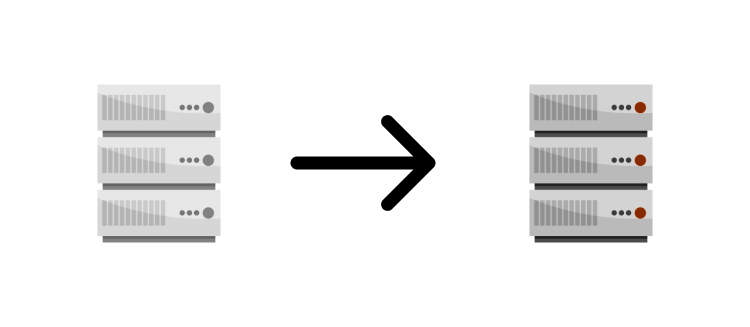- What Is Site Migration?
- What Are the Reasons for Site Migrations?
- What Happens When You Migrate Your Website?
- 9-Step Checklist on Website Migration
- 4 Advantages of Website Migration
- Risks of Website Migration
- Website Migration’s Impact on SEO
- Conclusion
While website migration can be beneficial, it also comes with inherent risks. Therefore, it’s crucial to follow a well-established process to minimize these risks.
In this guide, I will outline the steps involved in a website migration, provide a checklist to help you stay organized, and offer detailed explanations of each step.
Whether you’re a beginner or an experienced website owner, this guide will serve as your comprehensive resource for website migration.
What Is Site Migration?
Website migration involves making significant changes to your website that can affect its structure, performance, or traffic.
The term refers to the process of moving a website from one location to another, such as changing the hosting provider, moving to a new domain name, or changing the website’s content management system (CMS).

Website migration is usually done to achieve certain goals, such as improving site speed, enhancing site security, rebranding, or improving the overall user experience.
The most common type of website migration is the move from one domain to another, but it can also include transitioning from HTTP to HTTPS or changing the URL structure.
While website migration may be necessary for your business and offer numerous benefits, it’s important to proceed with caution. Poorly executed website migration can lead to site crashes, decreased traffic, and reduced revenue due to changes in usability.
However, these risks can be mitigated by following a proven website migration strategy, which I will outline below. By following this strategy, you can successfully complete your website migration without jeopardizing your site’s performance or traffic.
What Are the Reasons for Migrating an Entire Site?
Site migration can be done for various reasons that align with your business goals. For instance, you may need to make changes to your site structure, design, platform, user experience, or location.
One reason for migration could be to switch from HTTP to HTTPS for enhanced data security. If you are rebranding, you may need to change your domain name and URL to align with your new brand identity.
Another reason for migration could be to switch to a different web hosting or platform service that offers improved features or better functionality.
If you run an eCommerce store, you may need a new platform that offers advanced features to boost your sales. Alternatively, you may need to upgrade your existing platform to improve your site design and user experience.
Website migration may also involve changes to the site’s content and structure. For example, you may need to add new pages, modify your navigation or internal linking, or update your website’s design and media elements to improve performance and user experience.
In most cases, website migration involves multiple changes to your website. Therefore, it’s essential to understand the website migration process, prepare for it in advance, and follow a proven migration strategy to minimize risks and ensure a successful transition.
What Happens When You Migrate Your Website?
Website migration is a complex process that requires careful planning and execution. While the steps may vary depending on the specific reasons for migration, there are some universal steps that are essential to ensure a successful transition.

1. Plan The Process of the Site Migration
The first step in website migration is to plan the entire process well ahead of time. This includes identifying the goals and objectives of the migration, assessing the risks and challenges involved, and developing a comprehensive migration strategy.
2. Pre-launch Activities
The next step is to complete pre-launch technical activities, such as creating a backup of your existing website, setting up the new hosting environment, configuring the domain name, and ensuring compatibility with the new platform or CMS.
3. Perform a Test

Once the technical activities are completed, you’ll need to perform a test launch in a closed environment to ensure that everything is working as intended. This may involve testing the website’s functionality, performance, and user experience to identify any potential issues or bugs.
4. Execute Launch
After the test launch, you can execute the final site launch and bring the new website live. This may involve redirecting your old site’s URL to the new site’s URL, updating your site’s DNS settings, and testing the site for any last-minute issues.
5. Follow up and Evaluate
Finally, you’ll need to evaluate the metrics and performance of the new site for several months after the migration to identify any issues and make necessary adjustments. This may involve monitoring site traffic, search engine rankings, user engagement, and conversions to ensure that the migration has been successful.

Overall, website migration is a complex process that requires careful planning, technical expertise, and ongoing evaluation to ensure a successful transition.
Hiring a team of professionals to guide you through the process can help minimize risks and ensure that your new site is optimized for performance and user experience.
9-Step Website Migration Checklist Breakdown

1. Define the goal of the site migration process
Before beginning a website migration, it is essential to define the reasons behind it and what changes will be made to the site. This can involve transferring the entire site to a new domain or making changes to a portion of the current site.
Some common reasons for migration include moving to HTTPS, expanding the site’s reach with a better domain, going international, increasing search traffic, and improving site design.
By clearly defining the objectives and goals of the migration, such as retaining traffic levels or growing traffic, you can plan and prepare better for the process. It is crucial to be diligent and prepared to avoid creating a migration horror story.
Seeking advice and opinions from IT experts, SEOs, designers, and analytics teams both inside and outside your business can be invaluable for getting the migration right and avoiding potential issues.
2. Set budgets, timelines, and teams for successful website migration

After defining your goals and objectives, the next step is to create a comprehensive website migration plan that includes a sensible budget, timeline, and the teams responsible for each task.
It is crucial to have a clearly defined strategy as website migration is a complex process that requires effective communication among team members for a successful outcome.
To create a timeline, break down all the steps into deliverables and assign them to relevant teams while setting realistic deadlines using project management tools such as Wrike, Trello, or Asana.

All departments involved, including system admins, developers, SEOs, designers, UX developers, and copywriters, should have a role to play. It is also essential to schedule migrations during periods of low traffic to limit downtime’s impact on visitors.
A website migration doesn’t require a huge budget if you have the right skills in-house. However, it’s best to have a contingency budget in case problems arise that require an expert consultant’s help.
3. Promote your new website before the migration
Making sure that everyone knows about your site migration can be challenging. Although a 301 redirect can help redirect outdated links, they may still cause confusion and lose impact if they remain outdated for too long.
Informing Google of your URL change is relatively straightforward, but informing your customers is not. Therefore, it is essential to have a pre-migration promotional campaign that builds buzz and informs customers about the move before it happens. There are several ways to do this.

First, create a “coming soon” page on the new URL while working on the migration in the background. Promote the new URL using email and social media to customers and the press. The more buzz you generate before launch, the smoother the migration will be.
You should also be prepared for customers still searching for your old URL or brand name. Create a page on the new site that will rank for your old brand name and explain the move.
Additionally, set up PPC ads on Google to rank for queries related to your old name or URL. Paid campaigns targeting your new brand name can also help mitigate the fall in traffic that may occur directly after the migration.
4. Extract all website URLs using website migration tools
The vast majority of migrations will involve changing URLs. If this isn’t the case for you, you can skip this and the following step. If not, roll up your sleeves because this is where things get serious.
It starts with creating a content map.
Before you can go ahead and migrate your site, you need a complete picture of all your content. This will allow you to see which URLs need to be directed, which don’t, and where’s best to point them.
During website migration, it’s important to ensure that all internal links are properly redirected to avoid broken links and maintain the site’s SEO value.
Creating a content map will also highlight existing errors like bad redirects, 5xx errors, and pagination issues that you can fix before migrating.
Of course, don’t add new pages to your site while you’re creating your content map. Freeze content on your site for at least a month before getting started with your migration.

5. Create 301 redirects – start with the most relevant pages
After exporting the CSV file into a spreadsheet, carefully review each URL to determine which ones require redirection and which do not. While it may not be feasible to account for every page, prioritize those that have the most impact on traffic and revenue.
When redirecting a legacy URL, ensure that it goes to the most relevant new page, but never redirect it to your new homepage as it can lead to a negative user experience and trigger soft 404 errors. If a relevant page is unavailable, consider creating a new one or removing the legacy URL entirely.
It’s essential to confirm the URL structure of your new site before proceeding and making necessary changes to optimize SEO. You don’t want to waste time mapping out content for URLs that will change once the site goes live.
6. Run closed tests of the new site

Websites should undergo testing in a closed environment. This can help you identify any errors or issues that could negatively impact your site’s user experience or traffic after the migration goes live.
Testing the migration in a closed environment has several advantages.
- Firstly, any changes made won’t affect your live site.
- Secondly, keeping the old site live allows customers to continue using it and gives you a reference point for your changes.
- Thirdly, if something goes wrong, you can always start over if you use a closed environment.
The type of migration you’re undertaking determines the time you should start testing.
For example, if you’re launching a new design, you can start testing it as soon as it’s developed. Generally, the earlier you start testing, the better. This allows you more time to address any issues that arise.
Some errors may be minor, while others could be serious enough to impact your site’s future or result in penalties from search engines.
During testing for website migrations, it’s essential to check various aspects of your new site, such as site architecture, usability, mobile responsiveness, metadata, internal linking, search functionality, and other site features.
It’s also crucial to involve a team of people in the testing process rather than leaving it up to one person. A multi-disciplinary team is less likely to miss errors or mistakes that someone outside their area of expertise might overlook.
7. Track website migration project

As mentioned earlier, tracking specific metrics is essential to measure the success of your website migration. Therefore, it’s crucial to set up tracking before executing the migration.
If you haven’t already, install an analytics tool like Google Analytics to monitor your site’s performance. Then, track the traffic levels and top-performing pages for at least two weeks before the migration. This will establish a performance and traffic baseline that you can use to evaluate the migration’s impact in the future.
8. Migrate your website

After following all the steps on the website migration checklist, it is time to finalize the site migration. The process might have taken several weeks or months, but it will all be worth it if you can successfully complete the migration.
Now that you have arrived at this stage, time is of the essence, and it is important to execute the migration as quickly as possible. You will need to take your website offline during the migration process, and it’s crucial to minimize downtime to avoid any negative impact on your search engine rankings.
Once the migration is complete, ensure that your robots.txt file is no longer blocking search engines, test your redirects thoroughly, especially for your most valuable pages, and upload your new XML sitemap to Google Search Console.
9. Measure if it was a successful website migration

Once you’ve completed the migration, your job is not over yet. You need to track the success of the migration and make improvements where necessary.
Monitor the metrics that you set at the beginning of the process and compare them to the benchmarks you established beforehand over the following weeks and months. If they are in line with your expectations, that’s great. If not, you need to identify the problem.
It’s common to see a change, even a decrease, in traffic and rankings after a site migration, but if you experience a significant and long-lasting drop, it could indicate bigger issues, usually due to poor redirection practices.
It’s also essential to track the traffic levels and rankings of the legacy site. These should gradually decrease to zero over the year. If they don’t, double-check to ensure that the pages still receiving traffic are being redirected correctly.
If everything meets your expectations after a year, you can stop worrying about tracking and enjoy your new site.
4 Main Advantages of Website Migration

- When done correctly, site migrations can offer a great opportunity for a fresh start, rebranding, or business growth. It provides a chance to improve your website’s functionality or add advanced features by moving to a new platform.
- Moreover, it allows you to uplevel your user experience (UX) as your business evolves.
- Additionally, migrating from HTTP to HTTPS adds a layer of security to your data, which is always beneficial.
- Site migration also presents an opportunity to refresh your content and identify any technical issues that your site may have.
Website Migration Risks

A site migration gone wrong could have disastrous consequences.
One of the most significant issues is a decline in visibility. If your website cannot be found through organic search, your revenue could suffer a significant blow, and it may be challenging to recover.
Another concern is the potential decrease in your site’s authority if your old pages are not redirected correctly. This can occur if the newly migrated pages do not register the old backlinks. To avoid this, it is essential to redirect the old pages to the new ones so that the backlinks continue to work.
Additional issues that may arise during the migration include problems with analytics tracking, mobile responsiveness, and page speed.
To prevent such issues, it is vital to prepare thoroughly for the migration and work with a skilled web developer as needed.
Does Website Migration Impact Search Engines and SEO?

Yes, migrating a website will affect your search engine visibility, but it doesn’t necessarily have to be a negative impact. By creating a website migration plan, you can minimize any negative effects on your search engine rankings.
One essential part of this plan is to create an SEO specification document that outlines specific requirements for the migration process. This document will help your developer ensure that your SEO stays intact.
Despite the complexity and potential intimidation of website migration, following the necessary steps can open up new opportunities for your business.
Conclusion
In conclusion, website migrations are complex and challenging processes that require careful planning and execution. It can be a daunting task for any business, but with the right strategy, tools, and team in place, it can be a smooth and successful experience.
Whether you’re migrating to a new platform, redesigning your website, or consolidating multiple sites, it’s essential to follow a step-by-step process and ensure that you have a clear understanding of your goals and metrics. This will help you identify any potential issues and make informed decisions throughout the migration process.
Remember to involve all stakeholders and ensure that everyone is on the same page. Communication is key to a successful migration, and it’s important to keep everyone informed and involved throughout the process.
Once you’ve completed the migration, continue to track your site’s performance and make adjustments where necessary. With the right approach, website migration can be a powerful tool for improving your site’s user experience, SEO, and overall performance.
FAQ
There are various reasons why a website might require migration, including the implementation of a new design, changing web hosting providers, relocating to a different domain, or restructuring the site’s architecture. The aim of website migration is to ensure the smooth functioning of the site and to preserve its SEO value.
Although website migration can be done independently, it is often advantageous to seek assistance from a professional who has experience with the process. An expert can ensure a seamless transition, mitigate risks, and maintain the site’s SEO value.
If website migration is not done correctly, it can be a risky process that may lead to several issues such as loss of SEO value, broken links, website downtime, and decreased user experience. It’s crucial to plan and execute the migration meticulously to mitigate these risks.
Yes, website migration can have a significant impact on Google Search Console (GSC) as it involves changing the website’s URL structure, which affects the way Google indexes and ranks the website.
When you migrate your website to a new domain or make significant changes to your existing site, you need to update the GSC settings to ensure that Google can crawl and index your new site correctly.



